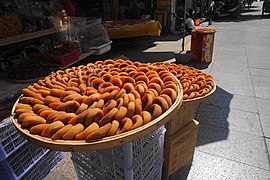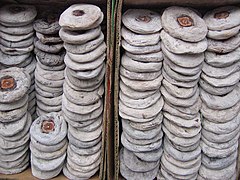Dried persimmon
 Dried persimmons | |
| Alternative names | Dried persimmon |
|---|---|
| Type | Dried fruit |
| Region or state | East Asia |
| Main ingredients | Oriental persimmon |
Dried persimmon is a type of traditional dried fruit snack in East Asia.[1] Known as shìbǐng (柿餅) in Chinese, hoshigaki (干し柿) in Japanese, and gotgam (곶감) in Korean, it is traditionally made in the winter, by air drying Oriental persimmon. It is also used to make wine, put in traditional tea,[2] and in creating other desserts.
In the Han Dynasty, Yangshao dried persimmon was used as a tribute to the imperial court.
Production[]

Dried persimmon are made from various varieties of Oriental persimmon. Persimmons, when fully ripe, are thin-skinned, soft and sweet. Persimmons used to create dried persimmons are harvested when they are under-ripe, firm, astringent, and bitter.[3]
China[]
In China, there are many different varieties of dried persimmon. The traditional way of dried persimmon is to choose the varieties which are fully mature, hard flesh, upright fruit shape, flat or slightly protruding top, no longitudinal groove, low sugar content, few seeds or no seeds. Remove mechanical damage and fruits. After peeling, select a place with sufficient light, air circulation, sanitation and cleanness, and build a frame with wooden sticks or bricks. The frame is 0.8-1m high and covered with foil. The top of peeled persimmon fruit is upward, and the single layer is placed on the foil and exposed to the sun. Cover it with a cushion at night in case of dew and rain. About 10 days later, the pulp shrinks and the top of the fruit sinks. The first time, and then every 3-4 days, the second time, persimmon outside hard, inside soft. Persimmon soft, no sweating phenomenon, so you can scrub. In addition, there are artificial drying method, this method product color yellow bright, sweet flavor, frost good, high quality. Dried persimmon in china is not a single variety, different regions have different characteristics and the production method, of which Xi'an dried persimmon is more famous.
Japan[]
In Japan, the fruit are peeled and then suspended by strings from their stems.[4] They are massaged daily after they have started to dry.[5] This gives the dried persimmon from Japan a distinctive shape and texture that is different from those from China and Korea.[6] Anpo-gaki is a variation of Japanese dried persimmon in which the persimmon is dried by fumigating with sulphur, resulting in a soft, juicy texture.[7]
Korea[]
In Korea, the persimmons are peeled and dried, tied with saekki (rice straw ropes) and hung in sunny, well-ventilated place, for example to the eaves of the house.[8][9] When the color turns brown and the outer part hardens, the seeds are removed and the persimmons are sealed again and flattened.[10] After around three weeks, when the fruits reach 75% of their original weight, they are covered in dried rice straw and stored in a box in a cool place until the drying process is completed, and a white powdery crust of persimmon sugar forms on the outside.[1] Sangju in North Gyeongsang Province is famous for its dried persimmons.[11][12]
Nutrition[]

Korean gotgam usually consists of 32% moisture, 6.3% protein, 0.44% fat, 44.8% carbohydrate, 15% fiber, and 1.99% ash.[10] calories (32g/ea) : 75.8kcal
Culinary use[]
In Korean cuisine, dried persimmons can be consumed themselves, or used as an ingredient in other foods. For example, gotgam-ssam (dried persimmon wrap) is made by wrapping a walnut with dried persimmon.[10] Dried persimmon with pine nuts inserted are served with suksil-gwa (a fruit confection) or fresh fruits.[10] Dried persimmons are also one of the main ingredients for sujeonggwa (cinnamon punch).[10]
In popular culture[]
According to Chinese legend, Zhu Yuanzhang was forced to live in exile to the foot of jinweng mountain in the north of Fuping. He was able to live because he ate local dried persimmons.
The Korean folktale "The Tiger and the Dried Persimmon" features a tiger scared of dried persimmon.[13][14]
Gallery[]

Hoshigaki served as a snack in Japan

Sliced gotgam served as a snack in Korea

Gotgam-ssam (dried persimmon rolls) made with walnuts

Japanese kagami mochi served with dried persimmon-skewers

Shibing of roadside sales in China.

Different varieties of dried persimmon in China
See also[]
References[]
- ^ Jump up to: a b Means, Becky (2 August 2010). "Dried Persimmon". Houston Press. Retrieved 3 June 2017.
- ^ "수정과". terms.naver.com (in Korean). Retrieved 2021-05-09.
- ^ "gotgam" 곶감. Doopedia (in Korean). Doosan Corporation. Retrieved 3 June 2017.
- ^ Wan Yan Ling. "Grocery Ninja: Dried Persimmons Are a Taste of Honeyed Sunshine". www.seriouseats.com. Serious Eats. Retrieved 15 May 2018.
- ^ "How To Make Hoshigaki (Dried Persimmons)". Root Simple. 13 November 2012. Retrieved 15 May 2018.
- ^ Mucci, Kristy (November 15, 2016). "This is the Kobe Beef of Dried Fruit". SAVEUR. Retrieved 19 May 2018.
- ^ "Go Go Tohoku". www.facebook.com. Retrieved 2020-09-01.
- ^ Korea Tourism Organization (5 October 2016). "Seasonal foods to eat this fall". Stripes. Archived from the original on 1 August 2017. Retrieved 3 June 2017.
- ^ "First lady to treat Trump couple with personally made refreshments". Yonhap News Agency. 7 November 2017. Retrieved 20 May 2018.
- ^ Jump up to: a b c d e 이, 효지. "gotgam" 곶감. Encyclopedia of Korean Culture (in Korean). Academy of Korean Studies. Retrieved 3 June 2017.
- ^ Chung, Kyung-a (October 2014). "Season of Beauty, Season of Plenty". KOREA. Korean Culture and Information Service. Archived from the original on 13 August 2017. Retrieved 3 June 2017.
- ^ Kim, Sun-mi; Kim, Sarah (20 August 2015). "Taste of a fruit is the only trace of a happy youth". Korea JoongAng Daily. Retrieved 3 June 2017.
- ^ Wi, Ki-cheol (2004). The Tiger and Dried Persimmon. Kookminbooks. ISBN 8911022241. Lay summary – Korea Literature Translation Institute.
- ^ "The Tiger and the Persimmon" (PDF). Jordan Schnitzer Museum of Art. University of Oregon. Retrieved 3 June 2017. Lay summary.
- Dried fruit
- Korean snack food






